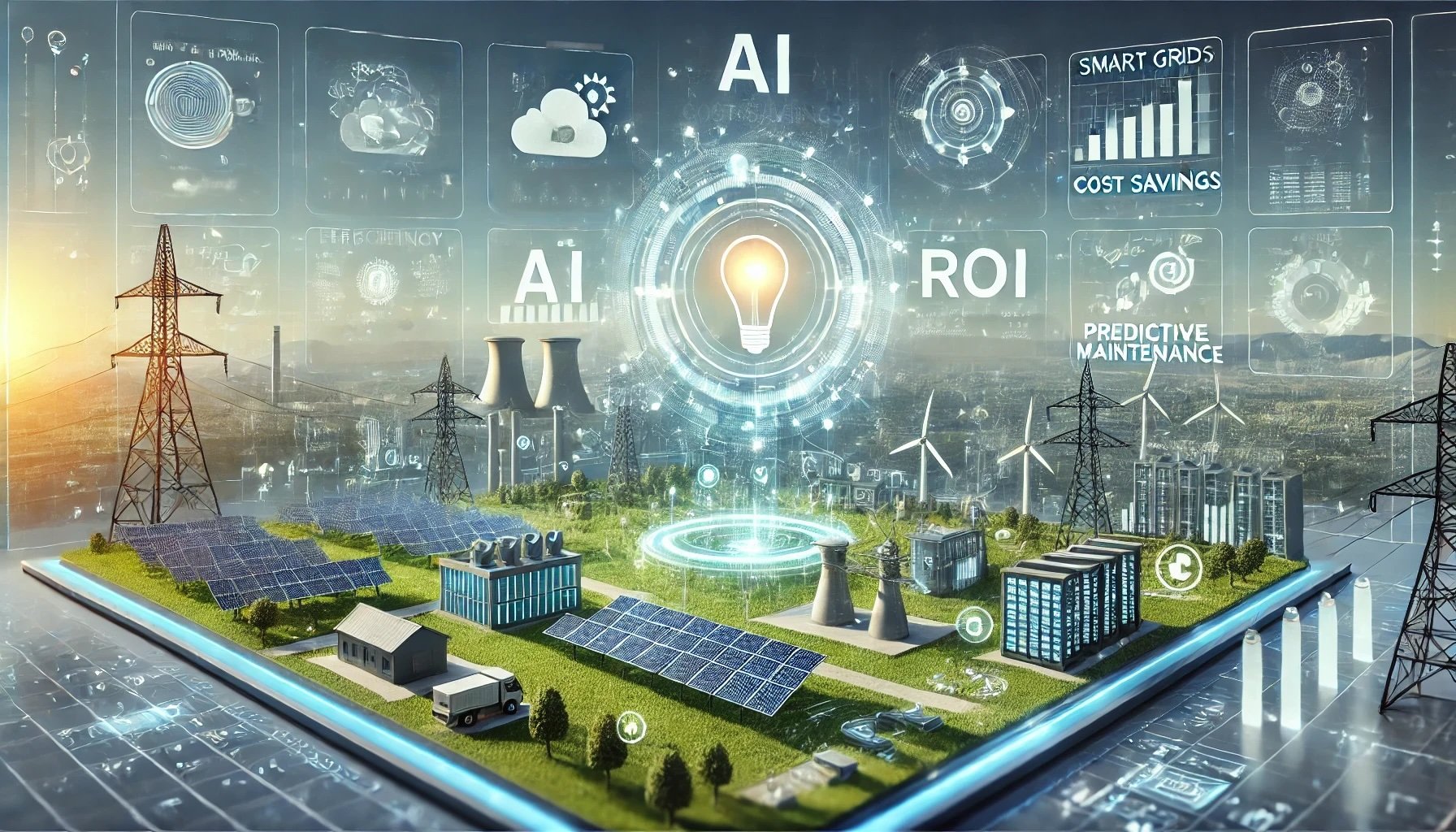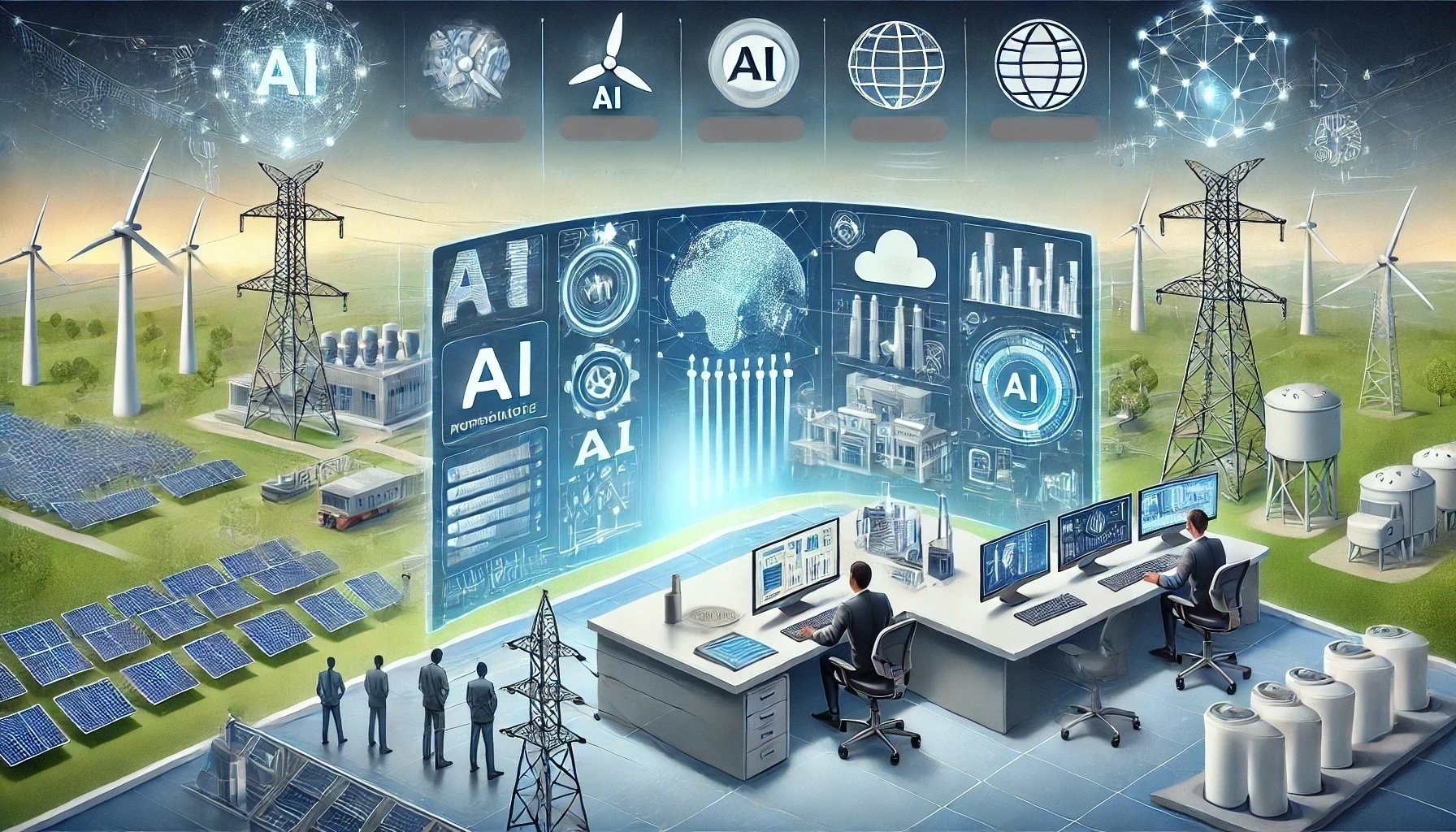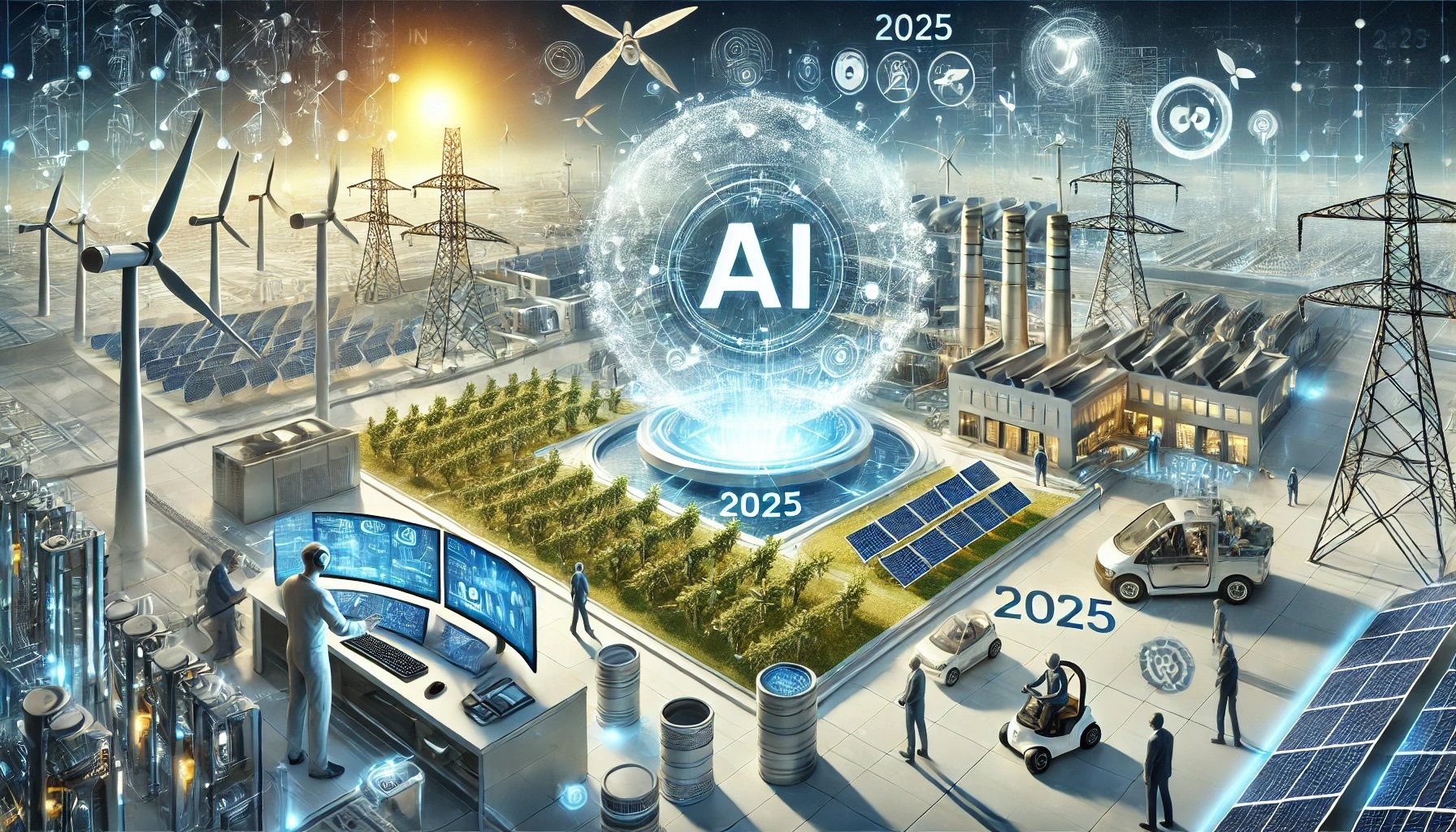7 Key AI Trends Transforming the Energy Industry in 2025
Introduction
Artificial intelligence is transforming industries at an unprecedented pace and the energy sector is no exception. Across power grids, oil fields and renewable energy farms, AI is revolutionizing how companies generate, distribute and manage energy. From predictive maintenance that prevents costly breakdowns to real-time energy demand forecasting, AI-driven solutions are making operations smarter, safer and more efficient.
The energy industry has long relied on automation, but what sets 2025 apart is the rapid acceleration of AI capabilities. Advances in machine learning, computer vision and big data analytics are enabling companies to process vast amounts of information faster and with greater accuracy than ever before. Whether it’s using drones to inspect solar panels, leveraging AI to predict energy demand fluctuations or optimizing carbon capture processes, companies are unlocking new levels of efficiency and profitability.
Traditional energy providers and renewable energy companies alike are facing increasing pressure to optimize operations, reduce costs and meet sustainability goals. AI-powered technologies provide a competitive advantage by automating critical processes, minimizing waste and ensuring more reliable energy distribution. By integrating AI into their strategies, businesses can not only improve day-to-day operations but also future-proof themselves against evolving industry challenges.
In this article, we’ll explore seven key AI trends that are reshaping the energy landscape in 2025. From AI-powered robotics and blockchain-enabled energy trading to intelligent emissions monitoring, these innovations are set to redefine how energy is produced, stored and consumed. Understanding these trends can help energy companies, grid operators and technology leaders stay ahead of the curve and maximize the potential of AI-driven advancements in the sector.
The 7 Key AI Trends Transforming the Energy Industry in 2025
Artificial intelligence is reshaping how energy companies manage infrastructure, optimize power distribution and ensure sustainable operations. From predictive maintenance to blockchain-enabled energy trading, AI is helping businesses operate more efficiently while reducing costs and environmental impact. Below are seven key AI trends that are driving transformation in the energy industry in 2025.
1. Predictive Maintenance & Asset Management
Energy companies rely on complex machinery — from power turbines to transformers and pipelines. Traditional maintenance methods often lead to unexpected breakdowns, costly repairs and operational downtime. AI-powered predictive maintenance is changing this by enabling early detection of potential failures before they become serious problems.
Machine learning models analyze sensor data, temperature variations, vibration patterns and historical performance records to predict when equipment is likely to fail. Computer vision enhances this process by automatically identifying cracks, corrosion or other structural issues in energy infrastructure.
Benefits of AI-driven predictive maintenance:
Reduced downtime: AI helps energy companies schedule repairs before failures occur, preventing costly disruptions.
Safer operations: Proactive maintenance reduces the risk of hazardous equipment malfunctions.
Lower costs: By preventing major failures, companies save on emergency repairs and extend the lifespan of their assets.
Technologies like OCR (Optical Character Recognition) and image labeling also play a role in asset monitoring. AI-powered OCR can automatically extract data from inspection reports, handwritten logs and equipment labels, making asset management more efficient.
2. Demand Forecasting & Load Management
Balancing electricity supply and demand is one of the biggest challenges in the energy sector. Too much power generation leads to waste, while insufficient supply results in outages. AI-powered demand forecasting helps utilities and grid operators optimize power distribution.
By analyzing historical energy consumption data, weather forecasts and real-time grid activity, AI can predict demand fluctuations with high accuracy. Smart grid systems use this information to adjust power distribution dynamically, ensuring efficiency and reducing operational costs.
Key benefits:
Optimal energy distribution: AI helps utilities generate and distribute just the right amount of power.
Minimized energy wastage: By accurately forecasting demand, excess power generation is reduced.
Cost savings: Energy providers can optimize resources and avoid overproduction or shortages.
AI-powered anomaly detection ensures that any unexpected changes in power consumption — such as sudden spikes or grid failures — are identified in real-time, allowing for swift corrective action.
3. Drone-Based Inspections & Monitoring
Energy infrastructure often spans remote or hazardous locations, making manual inspections time-consuming and risky. AI-powered drones are revolutionizing field inspections by providing automated, real-time monitoring of energy assets like wind turbines, solar panels and oil pipelines.
Drones equipped with high-resolution cameras and thermal imaging sensors can scan infrastructure and detect issues like overheating equipment, physical damage or vegetation encroachment on power lines. AI then analyzes the collected data and prioritizes critical repairs.
Advantages of AI-powered drone inspections:
Faster data collection: Drones can inspect vast energy facilities in a fraction of the time required by human teams.
Safer operations: AI-driven automation reduces the need for workers to enter dangerous environments.
Proactive maintenance: Early detection of damages helps prevent costly breakdowns.
To protect sensitive information captured during inspections, image anonymization APIs can automatically blur faces, vehicle plates or other identifiable objects, ensuring privacy compliance. Additionally, background removal helps focus AI analysis on the key elements of captured images.
4. Carbon Capture & Emissions Control with AI
As industries face increasing pressure to reduce carbon footprints, AI is playing a crucial role in emissions monitoring and carbon capture. AI-powered sensors and computer vision models can track emissions from power plants, factories and vehicles in real time, providing precise data for regulatory compliance.
In carbon capture processes, AI helps optimize storage solutions and chemical absorption techniques to enhance efficiency. AI-driven models simulate and predict the best methods for capturing and storing CO₂, reducing waste and maximizing output.
Key benefits:
Regulatory compliance: AI ensures accurate reporting of emissions data to meet global environmental standards.
Reduced carbon footprint: Optimized capture and storage processes contribute to sustainability efforts.
Stronger brand reputation: Companies that actively invest in emissions control improve their public image and gain investor trust.
AI-powered computer vision tools can also detect gas leaks using infrared imaging, helping prevent environmental hazards and financial losses.
5. AI-Driven Robotics for Energy Efficiency
Robots powered by AI are transforming the energy sector by taking over tasks that are hazardous, repetitive or require high precision. In solar farms, robots equipped with AI clean panels more efficiently than human workers. In offshore drilling platforms, autonomous machines perform routine inspections, reducing human exposure to dangerous environments.
AI-driven robotics use object detection and custom computer vision for real-time navigation and obstacle avoidance, ensuring smooth operations in dynamic environments.
Advantages of AI-powered robotics:
Minimal human risk: Robots handle high-risk tasks, improving worker safety.
High accuracy and consistency: AI ensures precision in operations like welding, drilling and equipment inspection.
Faster maintenance and monitoring: Automated systems reduce response times for equipment issues.
By combining robotics with AI-powered object detection, energy companies can improve asset management and operational efficiency across power plants and renewable energy sites.
6. Blockchain & AI for Secure Energy Trading
AI and blockchain are increasingly being used together to enable transparent and decentralized energy trading. Blockchain technology ensures tamper-proof energy transactions, while AI analyzes market trends to optimize pricing and predict fluctuations in supply and demand.
AI-powered forecasting tools allow energy producers to adjust output based on real-time consumption data, making energy markets more efficient. Additionally, AI enhances identity verification and fraud detection in blockchain-based platforms, ensuring secure transactions.
Key benefits of AI in energy trading:
Decentralized markets: Reduces dependence on intermediaries, lowering transaction costs.
Trustworthy settlements: Smart contracts automate energy purchases and enforce agreements.
Optimized pricing strategies: AI-driven analytics provide insights into market trends and demand shifts.
By integrating facial recognition and brand authentication technologies, AI can also improve user verification on digital energy trading platforms.
7. Virtual Assistants & Automation
AI-powered virtual assistants and automation tools are streamlining customer service and internal operations for energy companies. Chatbots equipped with natural language processing (NLP) handle customer inquiries, assist with billing issues and provide real-time updates on energy consumption.
Automation tools also process large volumes of data, reducing the need for manual intervention in administrative tasks. AI-driven OCR (Optical Character Recognition) extracts text from invoices, contracts and maintenance reports, speeding up workflows and reducing errors.
Advantages of AI-driven automation:
24/7 customer support: AI-powered assistants ensure round-the-clock service without human intervention.
Reduced manual workload: Automating repetitive tasks allows employees to focus on strategic initiatives.
Improved data accuracy: AI minimizes errors in document processing and record-keeping.
Additionally, face detection APIs can enhance security by enabling biometric authentication for energy facility access control and identity verification.
The energy industry is undergoing a major transformation, driven by AI-powered technologies that improve efficiency, sustainability and security. By adopting AI for predictive maintenance, demand forecasting, drone inspections, emissions control, robotics, secure trading and automation, companies can stay ahead of market challenges and unlock new growth opportunities.
These seven AI trends are not just futuristic concepts — they are already shaping the way energy is generated, managed and distributed in 2025 and beyond. Businesses that leverage AI solutions today will be better positioned to lead the energy revolution of tomorrow.
Potential Impact and ROI for Energy Companies
Artificial intelligence is not just a futuristic concept in the energy industry — it’s a game-changer that delivers tangible results. Companies that embrace AI-powered solutions are already seeing significant improvements in efficiency, cost savings and sustainability. But beyond these immediate benefits, AI also offers long-term strategic value, helping businesses stay competitive in an industry that is evolving faster than ever.
Immediate vs Long-Term Gains
One of the biggest advantages of AI in the energy sector is its ability to generate immediate operational improvementswhile laying the groundwork for long-term success. Companies don’t have to wait years to see the benefits — many AI applications deliver rapid returns by automating routine tasks, optimizing processes and improving asset performance.
Immediate Benefits of AI Adoption
Cost Savings Through Predictive Maintenance
AI-powered predictive maintenance tools detect early signs of equipment failure, allowing companies to fix small issues before they escalate into costly breakdowns. This reduces unplanned downtime, extends the lifespan of assets and lowers repair costs.Optimized Energy Distribution
AI-driven demand forecasting enables energy providers to adjust power generation based on real-time consumption data. This minimizes energy waste, reduces operational expenses and improves grid stability.Faster, Safer Inspections
AI-powered drones and computer vision systems can inspect infrastructure in minutes rather than hours. This not only speeds up maintenance workflows but also enhances worker safety by reducing the need for manual inspections in hazardous locations.Automated Data Processing
AI-driven OCR (Optical Character Recognition) can instantly extract data from invoices, maintenance reports and contracts, eliminating manual data entry errors and streamlining administrative tasks.
These immediate improvements lead to rapid efficiency gains, often within the first few months of AI implementation. However, the true power of AI lies in its ability to create long-term competitive advantages for energy businesses.
Long-Term Strategic Value
Scalability and Future-Proofing
AI-powered solutions grow with a company’s needs. As energy providers expand operations, AI can seamlessly scale to handle larger volumes of data, automate additional processes and integrate with emerging technologies like smart grids and autonomous energy trading.Regulatory Compliance and Sustainability
Governments worldwide are imposing stricter environmental regulations, pushing energy companies to reduce emissions and improve sustainability. AI-driven monitoring systems help ensure compliance by accurately tracking emissions, optimizing carbon capture processes and detecting leaks in real-time.Enhanced Market Competitiveness
Companies that integrate AI-driven solutions early gain a significant edge over competitors. Automated energy trading, demand forecasting and AI-powered asset management enable businesses to operate more efficiently, reduce costs and offer more competitive pricing in the market.Continuous Learning and Improvement
Unlike traditional software systems, AI models improve over time. The more data AI processes, the better it becomes at predicting equipment failures, forecasting energy demand and detecting inefficiencies. This self-improving capability ensures that energy companies stay ahead of industry trends and technological advancements.
Scalability and Flexibility
One of the greatest strengths of AI in the energy sector is its modularity. Businesses don’t have to overhaul their entire infrastructure to start benefiting from AI — they can adopt AI solutions incrementally, starting with ready-to-go APIs and expanding to fully customized solutions as needed.
Modular AI Services: A Scalable Approach
Many AI-powered solutions are designed to be plug-and-play, allowing companies to integrate them into their existing systems without complex modifications. Examples include:
Image Anonymization API – Automatically blurs sensitive data in inspection images and security footage to ensure compliance with privacy regulations.
Object Detection API – Identifies and labels equipment, pipelines and infrastructure components in real-time, improving asset monitoring.
OCR API – Extracts text from energy reports, invoices and operational documents, enabling seamless data processing and record-keeping.
Background Removal API – Enhances AI-powered drone and robotic inspections by isolating critical details in captured images.
These off-the-shelf AI solutions allow companies to start small, experiment with AI capabilities and gradually expand their use without major upfront investment.
Custom AI Solutions: Tailored for Maximum Efficiency
While ready-to-go APIs offer quick wins, some energy companies require custom AI solutions tailored to their unique operational challenges. Investing in a customized AI system can provide long-term cost savings, enhanced performance and a clear competitive advantage.
Benefits of custom AI solutions:
Specificity – Designed to meet the exact needs of an energy provider, whether for predictive maintenance, emissions monitoring or automated trading.
Integration – Seamlessly connects with existing enterprise systems, ensuring smooth data flow and decision-making.
Scalability – Evolves alongside the company, adapting to new technologies, regulations and market shifts.
Though custom AI development requires an initial investment, it pays off in the long run by reducing operational costs, improving accuracy and enhancing overall business performance.
AI is no longer an optional upgrade for the energy industry — it’s a necessity for companies that want to stay competitive in a fast-evolving market. The ability to reduce costs, improve efficiency, enhance sustainability and scale operationsmakes AI one of the most valuable investments for energy businesses in 2025 and beyond.
For companies looking to maximize their return on investment, the key is to start with modular AI solutions, assess their impact and gradually expand into custom AI development for deeper automation and optimization. By strategically integrating AI, energy enterprises can future-proof their operations and thrive in an increasingly digital and data-driven world.
Key Considerations When Adopting AI Technologies
Artificial intelligence is transforming the energy industry, offering automation, efficiency and cost savings. However, successfully integrating AI requires careful planning and strategic decision-making. Companies must navigate challenges such as data management, infrastructure compatibility, workforce adaptation, security risks and aligning AI initiatives with business goals. By addressing these key considerations, energy enterprises can maximize the benefits of AI and ensure a smooth transition into AI-powered operations.
Data Quality & Management
Data is the backbone of any AI system. The accuracy and reliability of AI models depend entirely on the quality of the data they process. Poorly labeled, inconsistent or incomplete data can lead to incorrect predictions, inefficiencies and costly errors.
Ensuring Clean and Well-Labeled Data
AI models, especially those used for predictive maintenance, demand forecasting and asset monitoring, require structured, high-quality datasets. Companies must:
Collect and organize operational data from sensors, meters and historical reports.
Label and categorize images, videos and numerical data for machine learning training.
Ensure regular updates and maintenance of datasets to prevent outdated information from affecting AI predictions.
Balancing Data Acquisition with Regulatory Compliance
Energy companies must comply with strict data privacy and security regulations, especially when handling images, customer records and emissions reports. AI-driven solutions that involve computer vision, OCR or drone-based inspections must anonymize personal or sensitive data to comply with industry regulations.
Best practices for compliance include:
Using image anonymization APIs to blur faces, vehicle plates and other private details.
Storing and processing data in secure cloud environments with access controls.
Implementing encryption and user authentication measures to prevent unauthorized access.
By prioritizing data integrity, organization and compliance, companies can ensure that AI models operate efficiently while meeting regulatory requirements.
Technical Infrastructure & Integration
AI-driven systems require modern computing infrastructure capable of handling large datasets, real-time analytics and machine learning workloads. Before adopting AI, energy companies must assess whether their existing IT systems can support scalable AI solutions.
Evaluating IT Readiness
Processing Power: AI models require significant computing resources, especially for real-time image processing, predictive analytics and automation tasks.
Storage & Bandwidth: High-resolution drone inspections, smart grid monitoring and emissions tracking generate vast amounts of data. A reliable cloud-based storage solution is crucial for efficiency.
Interoperability: AI must integrate with SCADA (Supervisory Control and Data Acquisition) systems, IoT devices and legacy software used in energy management.
Leveraging Cloud-Based AI APIs for Seamless Scaling
For companies that lack in-house AI infrastructure, cloud-based AI APIs offer a flexible and cost-effective alternative. These ready-to-use solutions allow energy firms to:
Deploy AI quickly without building extensive computing infrastructure.
Scale operations on demand by processing only the required amount of data.
Integrate AI seamlessly into existing workflows, such as predictive maintenance, energy trading and automated inspections.
By adopting cloud-based AI solutions, energy companies can avoid expensive infrastructure overhauls while still gaining the full benefits of AI-powered automation.
Workforce Readiness
AI adoption is not just about implementing technology — it’s about ensuring that employees can effectively use AI-powered tools. A workforce that understands and trusts AI is essential for long-term success.
Upskilling Employees for AI-Driven Operations
Energy companies must invest in training programs to familiarize employees with AI-powered systems, such as:
Predictive maintenance platforms that use AI to detect early signs of equipment failure.
AI-driven energy forecasting tools that optimize grid operations.
Automated document processing solutions that utilize OCR for streamlining paperwork.
Providing hands-on training ensures that employees understand AI recommendations and can interpret insights accurately.
Cross-Functional Collaboration
AI initiatives require close collaboration between IT, operations and business units to ensure smooth deployment. For example:
IT teams must ensure AI systems are integrated securely and efficiently.
Operations teams must use AI-powered tools for real-time monitoring and automation.
Business leaders must align AI strategies with company goals and ROI expectations.
By fostering cross-functional cooperation, companies can maximize AI’s impact while ensuring employee adoption.
Risk Mitigation & Security
As AI becomes an integral part of energy management, cybersecurity risks increase. AI-driven automation, real-time monitoring and digital energy trading platforms require robust security measures to prevent cyberattacks, unauthorized access and data breaches.
Protecting Critical Infrastructure from Cyber Threats
AI systems that control energy grids, pipelines and power plants must be protected against cyber intrusions. Companies should:
Secure AI-driven control systems with multi-layer authentication and encryption.
Implement real-time anomaly detection to identify suspicious activities.
Conduct regular security audits to assess vulnerabilities in AI-powered tools.
AI-Powered Security Measures
AI itself can help enhance cybersecurity. Machine learning algorithms can detect and respond to cyber threats in real time by:
Identifying unusual network behavior that may indicate a cyberattack.
Recognizing fraudulent transactions in blockchain-based energy trading.
Enhancing physical security by using AI-powered facial recognition for facility access control.
By integrating AI-powered security tools, energy companies can protect infrastructure, prevent disruptions and maintain operational stability.
Strategic Alignment
AI implementation must be strategically aligned with business goals. Companies should not adopt AI just because it’s a trend — they need a clear roadmap to ensure long-term profitability and operational efficiency.
Defining Clear Objectives
Before deploying AI, companies should establish:
Specific goals (e.g., reducing maintenance costs by 30%, automating 50% of inspections, improving energy demand forecasting by 20%).
ROI metrics to measure AI’s financial impact.
Scalability plans for future AI expansion.
Without clear objectives, companies risk underutilizing AI solutions or investing in technologies that don’t align with business priorities.
Choosing Between Off-the-Shelf AI vs Custom Solutions
Energy companies must decide whether to use pre-built AI APIs or invest in custom AI solutions.
Off-the-Shelf AI APIs (e.g., object detection, OCR, background removal) offer quick deployment and lower costs. They are ideal for routine tasks like automated inspections, document processing and grid monitoring.
Custom AI Solutions require higher initial investment but deliver long-term cost savings and specialized automation. They are suitable for unique business needs such as proprietary energy trading models, advanced emissions control and complex predictive analytics.
By carefully evaluating AI investment options, companies can balance cost, efficiency and scalability while maximizing their competitive advantage.
AI adoption in the energy industry brings immense opportunities, but companies must prepare strategically to maximize its benefits. Ensuring high-quality data, modern IT infrastructure, workforce readiness, cybersecurity and clear business alignment are essential for success.
By addressing these key considerations, energy companies can unlock AI’s full potential, reduce operational costs, improve sustainability and future-proof their business against industry disruptions.
Implementation Strategies and Challenges
Integrating AI into the energy sector is not just about adopting new technology — it requires a structured approach to ensure smooth deployment and long-term success. Companies must carefully plan their AI strategy, address common challenges and consider future scalability. From conducting data audits to overcoming legacy system limitations, the path to AI-driven transformation involves multiple steps.
Key Steps for Adoption
Successfully implementing AI in energy operations begins with a well-structured adoption plan. Companies that rush into AI without proper preparation often face inefficiencies, poor results and wasted investments. Below are the key steps to ensure a smooth AI deployment:
Conducting Data Audits and Identifying Gaps
AI models thrive on high-quality, structured data. Before implementing AI-powered solutions, companies must evaluate their existing datasets to determine whether they have the necessary information to train machine learning models effectively.
Assess the completeness and accuracy of data collected from sensors, energy grids, maintenance reports and customer interactions.
Identify gaps in data collection, such as missing real-time monitoring capabilities or incomplete historical records.
Ensure data is properly labeled and structured for AI models, especially in computer vision applications like infrastructure inspections and predictive maintenance.
A strong data foundation ensures that AI solutions operate with precision and deliver reliable predictions and automation.
Choosing the Right AI Partners or In-House Resources
Once data readiness is established, the next decision is whether to build AI capabilities in-house or partner with AI service providers.
In-house AI teams offer more control over AI customization but require significant investment in talent, infrastructure and ongoing maintenance.
AI solution providers offer ready-to-use APIs and custom-built AI models, reducing implementation time and costs. These providers specialize in AI applications such as object detection, OCR, energy demand forecasting and emissions monitoring.
Hybrid approaches allow companies to integrate pre-built AI APIs for certain functions (e.g., automated inspections) while developing proprietary AI solutions for more complex challenges.
Choosing the right strategy depends on budget, technical expertise and business objectives.
Setting Performance Indicators Aligned with Business Goals
To measure AI’s effectiveness, companies must define clear performance indicators (KPIs) tied to operational and financial goals. These could include:
Reduction in unplanned equipment failures (measuring predictive maintenance success).
Decrease in energy waste (evaluating demand forecasting accuracy).
Cost savings in operational processes (quantifying AI-driven efficiency improvements).
Reduction in regulatory fines (measuring AI’s effectiveness in emissions tracking and compliance).
Having measurable KPIs ensures that AI investments provide tangible business value.
Common Hurdles
Despite the benefits, AI adoption in the energy industry comes with challenges. Companies must anticipate and proactively address these issues to avoid roadblocks.
Integration with Legacy Systems and Complex Technology Stacks
Many energy companies still rely on outdated infrastructure that was not built to handle AI-powered automation. AI solutions often require real-time data access and cloud computing power, which legacy systems may lack.
Challenge: AI models need to integrate with existing SCADA (Supervisory Control and Data Acquisition) systems, IoT networks and data lakes, which may require upgrades.
Solution: Implement AI-powered solutions that support modular integration, allowing gradual adoption without replacing entire systems at once.
Cloud-based AI APIs offer a way to overlay AI functionality onto legacy infrastructure without requiring a full system overhaul.
Handling Data Security and Privacy Risks
AI solutions in the energy sector often rely on visual and sensor data collected from industrial sites, drones or smart meters. This presents data privacy and cybersecurity concerns, especially in regulated environments.
Challenge: Sensitive images, facility blueprints and customer data must be protected from unauthorized access.
Solution: Use image anonymization APIs to automatically blur confidential details while maintaining AI’s ability to analyze infrastructure conditions. Additionally, implement end-to-end encryption and multi-factor authentication for AI-powered systems.
By prioritizing data security and privacy compliance, companies can safely leverage AI while avoiding potential legal risks.
Adhering to Evolving Regulations
AI deployment in the energy sector must comply with regional and international regulations concerning emissions reporting, cybersecurity and consumer data protection.
Challenge: Governments are introducing stricter AI-related regulations, requiring energy companies to maintain transparency and auditability of AI decisions.
Solution: Choose AI solutions that provide explainable AI (XAI) capabilities, ensuring that decision-making processes can be tracked, verified and adjusted when necessary.
Staying ahead of regulatory changes helps companies avoid fines and ensures smooth AI adoption.
Long-Term Vision
While AI implementation may require significant upfront investment, the long-term benefits far outweigh the initial costs. Companies that take a strategic approach to AI adoption position themselves for sustained success in a rapidly evolving industry.
The Case for Investing in Custom AI Solutions
Energy companies that rely only on generic AI solutions may miss out on long-term cost reductions and operational optimizations. While off-the-shelf AI APIs offer quick wins, custom AI models provide:
Greater accuracy in energy demand forecasting, predictive maintenance and emissions monitoring.
Tailored automation for industry-specific workflows, reducing inefficiencies.
Scalability and adaptability to future business needs and regulatory changes.
A well-planned investment in custom AI development creates a competitive advantage by reducing long-term operational costs and improving decision-making accuracy.
Sustained Growth, Innovation and Competitive Advantage
AI adoption should be seen as a continuous journey, not a one-time implementation. Companies that embrace AI as a core part of their strategy can:
Improve resilience by using AI to detect system failures early, optimize energy use and automate inspections.
Increase efficiency by integrating AI-driven robotics for energy facility maintenance and drone-based monitoring.
Enhance decision-making with real-time analytics and intelligent automation.
The energy sector is becoming increasingly AI-driven and organizations that invest in AI now will be better prepared for future advancements.
Implementing AI in the energy industry is a transformative opportunity, but it requires careful planning, strategic alignment and proactive risk management. By following structured adoption strategies, addressing integration challenges and maintaining a long-term vision, companies can successfully leverage AI to reduce costs, improve efficiency and enhance sustainability.
Energy businesses that take AI seriously today will shape the industry’s future tomorrow, leading the way in innovation, automation and operational excellence.
Conclusion
The energy industry is undergoing a major transformation and artificial intelligence is at the heart of this change. From predictive maintenance that prevents costly breakdowns to AI-powered demand forecasting that optimizes energy distribution, these technologies are redefining how companies generate, manage and consume energy. The adoption of AI is not just about increasing efficiency — it is about ensuring sustainability, reducing costs and maintaining a competitive edge in an industry that is evolving rapidly.
Each of the seven key AI trends we explored brings specific advantages to energy companies:
Predictive maintenance and asset management reduce downtime and operational risks by detecting potential failures before they happen.
Demand forecasting and load management ensure efficient power distribution and minimize energy waste.
Drone-based inspections and monitoring improve safety and accelerate maintenance processes in remote or hazardous environments.
AI-driven carbon capture and emissions control help energy providers meet strict environmental regulations and advance sustainability efforts.
Robotics in energy efficiency reduce human risk while automating complex tasks in power plants, solar fields and offshore platforms.
Blockchain and AI in energy trading bring transparency, security and automation to energy transactions.
AI-powered virtual assistants and automation streamline customer service, administrative processes and workforce management.
These advancements are not just incremental improvements — they are game-changers that are reshaping the entire energy ecosystem. Companies that implement AI-driven solutions today will see immediate cost savings, enhanced reliability and improved operational efficiency while positioning themselves for long-term growth.
Seizing Opportunities: Why Energy Companies Should Act Now
AI is no longer a futuristic concept in the energy industry. It is a practical tool that delivers measurable results. Companies that delay AI adoption risk falling behind as their competitors automate key processes, optimize efficiency and gain insights from real-time analytics.
For businesses looking to start their AI journey, the best approach is to:
Leverage ready-to-use AI APIs for quick wins in areas like image analysis, object detection and automated monitoring.
Explore predictive analytics for optimizing energy consumption, reducing downtime and improving decision-making.
Invest in automation to streamline operations, from customer service chatbots to AI-powered grid management.
Even for companies that already use AI, there is room for expansion. Custom AI solutions can further refine process automation, improve asset performance and create entirely new business models. AI is not just about optimizing existing workflows — it is about unlocking new revenue streams, reducing costs and driving innovation at scale.
Looking Ahead: The Future of AI in Energy
As AI technology continues to evolve, its role in the energy sector will only grow stronger. By 2025 and beyond, we can expect even greater advancements in:
AI-powered smart grids that automatically balance energy demand and supply in real-time.
More sophisticated predictive maintenance systems capable of diagnosing complex failures before they occur.
Increased integration of AI in renewable energy management, ensuring higher efficiency and reliability of solar and wind power.
Greater use of AI-driven automation and robotics in hazardous environments, reducing risks for human workers.
Stronger AI-driven sustainability efforts, with intelligent emissions tracking and automated carbon offsetting solutions.
The energy sector is moving toward a future where data-driven decision-making, AI-powered automation and sustainability-focused innovation will define success. Companies that embrace these AI-driven trends will lead the industry forward, shaping a more efficient, resilient and environmentally responsible energy landscape.
For energy-focused businesses, the time to act is now. AI is no longer a competitive advantage — it is a necessity for staying ahead in a rapidly changing industry. By making strategic investments in AI today, companies can future-proof their operations and play a pivotal role in the energy revolution of tomorrow.





